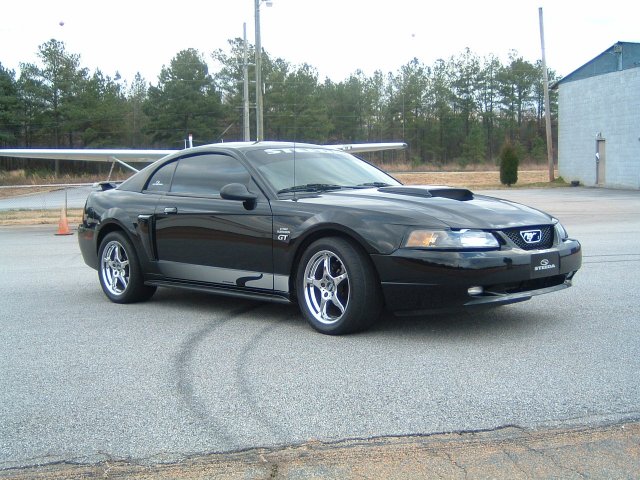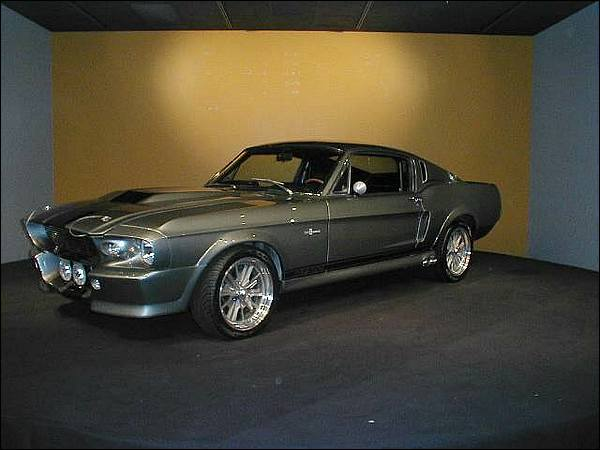| Home Page
Photo Page
Favorite Links
Photo2 Page
Photo3 Page
Photo4 Page
|
|
 |
Hey
This website is just something I started working on. It's basically about cars and car performance. |
My Car
I have a 2001 Mustang Steeda GT; it's car #30 from the Steeda factory in Pompano Beach Fla. It has a 4.6L(281 cid) SOHC,16 valve engine producing 260 bhp @ 5250 rpm and 302 lb-ft @ 3500 rpm. It runs the 1/4 mile anywhere between 13.7 sec and 14.2 sec @ ~101 mph. 0-60 sprint in 5.3
All of the modifications were put on at the Steeda factory in Pompano Beach, Fla. when it was brand new; I am the second owner (picked it up on 1/17/03). It has the Steeda Stage I G-Trac suspension package which consisits of:
Steeda Sport Springs (1.25" drop)
Steeda Strut Tower
Steeda G-Trac brace
Steeda Caster/Camber plates
Besides the suspension portion of the package, it also has:
Steeda Tri Ax shifter
Flowmaster 40 original series
K&N Filtercharger
Steeda 17"x9" Chrome Ultra-lights
Nitto 555 ZR Extreme 275/40/17
Steeda Billet Aluminum Pedal Covers
Steeda Floor Mats
Steeda Billet Aluminum A/C knobs
|
Nitrous Oxide vs. Turbocharging vs. Supercharging
If you're the type of enthusiast who treats a car as if it were your best friend, then I know you already started with the basic accessories (tires, suspension, stereo and so forth). Now you feel you're ready for some engine performance, but you have a few questions on which way to turn. Three of the most common ways pick up substantially more horsepower are by bolting on turbocharger, supercharger, and nitrous kits.
To figure out which is best for you, determine why you need additional power. Engine compartment space and your budget should be taken into consideration. For cost conserns, a nitrous kit is the most practical of the three bolt-on kits. The cost of a turbocharger or supercharger kit is quite a bit more, but you'll find that the power delivered from the turbo or supercharger is more useable, especially for road racing. Here are some of the pros and cons of each system.
Performancewise, a nitrous bottle is excellent if you're drag racing and as long as your car is going straight when the nitrous kicks in. Most nitrous systems are designed to work when the throttle is wide open so a nitrous system is not something you'd want for road racing. Introducing nitrous during a turn can cause the back end of your car to want to swap places with the front end (spin out). For road-racing you would want either a supercharger or turbocharger.
The design of a turbocharger is very simular to that of the supercharger. The difference being one is exhaust-driven(turbo) and the other belt-driven(supercharger). The general rule is that a turbocharger maximizes your powerband at a higher rmp, because it is powered by the amount of exhaust being forced through it. On the otherhand, a supercharger has better lowend torque, since it is controlled by a belt directly connected to the crankshaft. A supercharger is already injecting air into the system, even at extremely low rpm. Generally, superchargers cost a little more than turbo kits, but a turbo kit is tougher to install, as you must typically route your exhaust system through the turbocharger as well as add an intercooler.
The ideal situation would be, of course, to have all three(turbo, supercharger and nitrous) adding power to your car. Unfortunately, that may be an unrealistic dream, slightly out of reach for the common performance enthusiast. Below will explain the principles of each kit.
Turbocharger
A turbocharger is an air pump designed to operate on the normally wasted energy in the engine's exhaust system. The exhaust gases that would normally flow out of the tailpipe are instread routed through a turbocharger unit mounted adjacent to the engine.
Inside the turbocharger are two back-to-back turbines. On the exhaust side, a turbine uses the exhaust gases flowing through it to spin. When the exhaust-side turbine spins, so does the other turbine, forcing air into the intake of the engine. The exhaust output controls how fast the turbine spins, so at slower revs the turbine spins more slowly-and forces less air into the intake of the engine. If the force of the exhaust gases is low enough, the turbo will barely spin, if at all. As the engine rpm increases, the turbine spins faster and forces more air into the engine's intake. This is why turbos tend to work better at higher rpm and why turbochargers experience what is called turbo lag(the delayed time it takes for the turbine to spool up). Some companies use twin turbo systems, which compensate for the low/high-end sacrifice by dedicating one turbo to each situation.
Supercharger
A supercharger is much like a turbocharger, with the biggest differnce being that a supercharger is connected directly to the crankshaft with a belt. A supercharger is matched to an engine by its displacement and belt ratio. It can provide excess airflow at any engine speed. The concentrated charge of air provided by a supercharger results in a more powerful combustion stroke in the engine's cylinders, resulting in improved engine performance. A supercharger is a self-contained unit, while the turbocharger relies on the engine's exhaust system- and, often, an intercooling system- to function.
Nitrous Oxide
A nitrous system is made up of just a few components. The biggest component is the nitrous bottle itself, which is generally(because of its size) located in the trunk of your car. The most common bottle is an aluminum tank with a 10-pound capacity.
A high-pressure hose delivers the nitrous from the bottle to the rest of the system under the hood. Two solenoids control the nitrous and fuel. The nitrous ad fuel are still seperated from each other as they travel to the jets, which set the calibration for the whole system. The jets are typically small brass inserts that can be easily changed for tuning purposes. Once they've passed through the jets, the nitrous and fuel are introduced into the engine.
There are numerous ways to introduce nitrous and fuel into the engine. The most common method uses a thin plate mounted atop( or between the two halves of) the intake manifold. The plate has thin brass tubes that are paired together. One tube is positioned over the other, and the upper tube usually flows nitrous, leaving the lower one for fuel. The high velocity of the nitrous as it comes out of the tube helps atomize the fuel.
The nitrous can be activated in many ways; it is usually controlled by a switch operated by the driver. Nothing makes it easier to dramatically increase the power output of an engine than a nitrous system does. I think that nitrous is a gay way of adding power because it often ends up destroying your engine and it isn't real power, it's what all the rice boyz use in their 4 cylinder Hondas to gain mad gumbee horsepowa yo! And they wonder why their engine blows up after a 150 shot, dumbasses. By the way NOS is a company that makes nitrous kits, and so is NX. nitrous oxide is N20, commonly referred to as nitrous, NOT NAWWWS!
|
AWD vs. RWD
All have their merits, and their downsides.
Personally its all about the RWD. Its simple the fastest drive arangement out there. And probably always will be. Plus you can do all sorts of fun drifting in it, and as a general rule at high speed it is the easiest to control. You just have to watch the right foot on a car with alot of HP. Or you will be going backwords in a real hurry (depending on how the car is set up). The general technique for a RWD car is throttle oversteer.
AWD is a decent alternative to RWD, but the drivetrain sucks to much power, so it's not incredibly practicle. But its still nice. AWD takes a mix of technique to drive properly. You have the throttle over steer of a RWD car, with left foot brake over steer, and lift off oversteer of a FWD. It is just a different technique to drive AWD. But once you get the hang of it, on a loose surface there is no comparison. Even though I do prefer RWD, AWD on gravel is far superior.
AWD takes alot of input from the driver, through the throttle, brakes, and steering. And mixes alot of various techniques together to keep it stable. Alot of people talk about how much easier AWD is. In limit driving its actually HARDER to control, because you have alot of push understeer, which can quickly turn into snap oversteer, and unless you throttle hard out of it, you will pendulum swing and look like some rice boy trying to drift his Civic DX. But once learned it IS fast...its just not as easy as Subaru would have you believe.
Send me an e-mail
|

Real Muscle
1967 Shelby Mustang GT500
|
|
|


